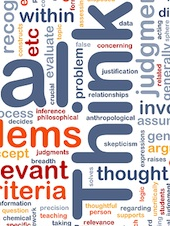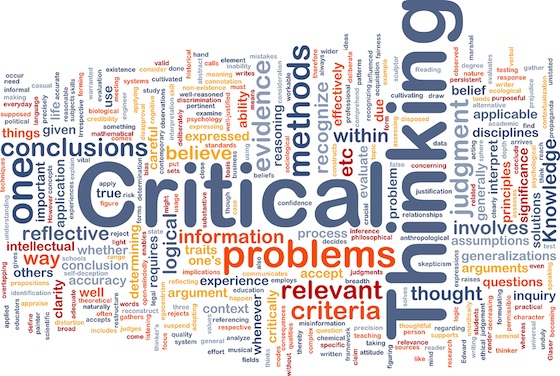As a child, I grew up in a world that was dominated by left-brained thinking. Both my parents were in professions that required in-depth analytical thinking. The “rule” in my house was: “If you break something, try to fix it. Only THEN come ask Dad for help.” Dad was an avionics engineer and had an incredible mechanical ability. He could fix anything, and he instilled within his children a desire to understand how things work and a hunger to ask questions that clarify thinking.
Looking back now, I realize something I never understood then — what he had instilled was an ability to think critically. Along with creativity, collaboration, and communication, critical thinking is one of the four components of learning in the 21st century. Unlike the other three, critical thinking is often difficult to reduce to bite-size pieces of understanding and challenging to teach to others.
Several months ago, as I was visiting one of our diocese schools, I was fascinated that a first grade teacher was actually teaching critical thinking to her students within a math lesson. The students had to create number sentences with the numerals of 5, 3, and 2. I was fascinated when she asked for volunteers (in pairs) to come to the whiteboard, write down their first sentence, and then, using manipulatives, prove that the sentence was correct. The other students “voted” whether or not the sentence was correct by either “a thumbs up” or “a thumbs down.”
The addition sentences were easy for the six and seven-year olds. The subtraction ones proved to be a bit challenging. Students could “phone a friend” or “ask for help.” If the partners still couldn’t solve the problem, the teacher intervened with some targeted questions and demonstrations using manipulatives. As I sat there in the back of the room, I was awed by the way the teacher got her students to think and work with one another!
Reflection, Reasons, Alternatives
Shortly after my classroom visit, I came across a website dedicated to teaching critical thinking. Upon diving deeper within the site, it was obvious why this is such a key component to 21st century learning. Robert H. Ennis, author of the site, suggests three underlying components to critical thinking: reflection, reasons and alternatives.
Reflection always includes stopping and thinking before making rash judgments about the topic at hand. I have personally witnessed deep reflection by many students as they comment and question both within their personal and/or class blogs and wikis and during face to face communication). The use of blogs and wikis make it possible for others within their learning community, not just their class, to question their thinking patterns, thus deepening their learning experience.
 It never ceases to amaze me how deep the learning experience can become when ideas are critiqued by others. So many good teachers I’ve had the opportunity to observe understand this concept and invisibly incorporate this within their teaching style.
It never ceases to amaze me how deep the learning experience can become when ideas are critiqued by others. So many good teachers I’ve had the opportunity to observe understand this concept and invisibly incorporate this within their teaching style.
‘How do you know what you know?’ and ‘Why do you think that?’ are questions that are often voiced by teachers and students alike. This is the core of the reasoning part of critical thinking. Individual thought patterns can be the result of cultural experience and/or a lack of personal experience. Questions like the above, from members within a learning community, broaden perception and deepen understanding.
Today’s learners must be put into situations that help grow global awareness and insight in order to make good decisions personally, professionally, and politically. These attributes heighten the awareness of the similarities and differences of individuals, thus creating depper insights into what being human is all about.
Finally, in today’s world, learners of all ages need to understand that there are many ways to arrive at a good answer to a problem. They need lots of practice exploring alternatives. I have often said, “There is more than one way of getting to 2 besides 1+1.” This is the creative side of critical thinking. Students should be given time to delve into questions in order to explore every dimension of the problem or question. This is when authentic, sticky, deep learning occurs.
Overall, I must acknowledge that our schools are filled with examples of teachers doing an excellent job teaching our young people to think critically. As I travel and visit schools and classrooms, I am often awed at the excellence that I find. It’s “Absolutely Amazing!” and all too often unrecognized or underappreciated in a world where so many are quick to be critical of schools without doing much critical thinking themselves.
Sr Geralyn Schmidt
Latest posts by Sr Geralyn Schmidt (see all)
- Virtual Integrity and the Digital Citizen - April 27, 2019
- Eight Aspects of Good Teaching - December 4, 2013
- Does Your School Need a Culture Re-Boot? - August 15, 2013



These ARE THE questions that everyone should be asking their students. They are much harder and that makes people feel uncomfortable. I agree that some people are getting the hang of incorporating this kind of questioning into their classroom. It doesn’t have to be an all or nothing kind of experience.
But isn’t the whole point of an education to prepare a person to wrestle with ideas and to keep at the struggle?
Thanks for re-focusing us on these ideas….especially as we spend the summer recalibrating our own courses.
Marsha,
It never ceases to amazing me that learning can indeed be a STRUGGLE. But this kind of struggle is good! It often reminds me of a butterfly finally being freed of its cocoon. HARD but so beautiful!
Thanks again for your words of encouragement.
This post came to my attention at the perfect time. This is something that I struggle with everyday with my students. Teaching middle school has its challenges, but the biggest is getting them to think critically. Thank you for this post and the resources you included.
Thea,
Dont give up the fight about teaching your students how to think critically. This is such an important skill! They totally need this skill as they venture forward.
Thanks for your comment.
I am encouraged and inspired each time I encounter another visionary educator who recognizes the value in the explicit teaching of critical and creative thinking. Thank you for pointing out that there are indeed excellent teachers and schools that view the teaching of thinking not just an enhancement to be addressed when convenient, but have prioritized it as a necessity for effective learning and achievement. I know of a few schools in within the Dioceses of St. Augustine in north FL that are on the same path. Perhaps, we could collaborate to create a consortium of “thinking schools!”
Sheryl,
I would ABSOLUTELY LOVE to collaborate with you and your students!
The ability to think, to ask the question, “WHY do you think that?” truly needs to be a part of every teachers questioning power!
Thanks for your comment!
As a school coach working on just this idea with schools all over the country through our Critical Skills Program, let me add a hearty “Yes! This!” to what you’ve written here. We’re seeing more and more classrooms where this is the goal and folks like you just help fan the flames. Thanks so much for this !
Dear CS,
No thank you for your work to make Critical Thinking something that educators truly THINK about!
You hit all the right notes; this is a beautiful piece.
Of course, it’s easier said than done, and I know teachers are increasingly burdened in their work and will find it hard to meet the standard you set for critical thinking without support and coherence from their entire school community.
I’m most heartened that your reference to 21st century skills does not include technology as the centerpiece. I’ve been trying to find these words for 15 years to explain that “No, just having a SMART board doesn’t mean a classroom is prepared for the 21st century.”
I came up with a word that I think covers all your definitions of 21st century skills: curate. See my blog post http://www.harlemlink.org/blog/?p=359.
Thank you for your words!
Thanks Steven for your words. Yes, critical thinking is truly such an important part of what we need to actually TEACH the learners that sit infront of us. You are correct to say that the entire learning community needs to address this important issue. There are prophet teachers out there that do this on their own, but it is better if the entire learning community jumps aboard and focuses on this as an action item.
Thanks for including your blog about this as well!
Hello:
I’m not sure if you welcome new critical thinking resource submissions, but I forward the following links just in case. The book evolved from a rather unique course developed about ten years ago at Selkirk College. The concepts are still taught to management students in our School of Hospitality & Tourism. The book offers novel interpretations of the thinking process, and different pedagogical approaches that have been well received by students. At any rate, if new resources are sought or evaluated, here’s one for consideration. Best wishes for summer 2012.
Steve Bareham, Selkirk College, Tenth Street Campus, Nelson, B.C.
Book details:
http://www.amazon.com/Think-Well-Prosper-ebook/dp/B008FF6TZW/ref=sr_1_4?s=digital-text&ie=UTF8&qid=1341501219&sr=1-4&keywords=Steve+Bareham
PowerPoint slides from presentation at Rotary Youth Leadership Awards, Selkirk College, July 4, 2012:
http://www.slideshare.net/SBareham/ryla-show-13553409
I am on day 7 of a series of blog posts about teaching fractions to fourth graders in a very constructivist manner–and asking the tough questions and asking them to struggle. We must continue to show students that struggle is good–and that great minds can work together, discuss together, and eventually solve any problem they are faced with! What is worthwhile is not always easy, and asking students to build their own meaning requires a gentle touch by teachers and parents–but it is essential. Nice post–thanks!
Dear Fourth Grade,
Yes I agree with you about the importance in asking tough questions. This has to be part of our instruction since these questions and the way to think in this manner is such a part of today’s job world.
It sounds that you understand the essential truth of this post. Keep up the good work!
This is so clearly written and so easy to understand, I plan to use it with my students! I am teaching in Kazakhstan, south of Russia, and teaching high school students in a research course that demands critical thinking. Thank you for your clarity, for your simple language, and for your depth of thinking in this writing. May the Lord bless you in your continued service!
Dear Bea,
Thanks for your comment. I am humbled by the fact that these few suggestions are being implemented in a classroom as far away from me as Russia! May God bless you in your ministry as well!